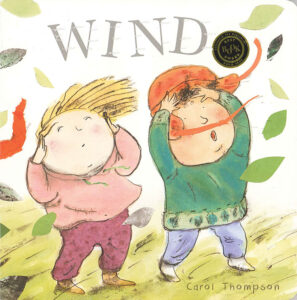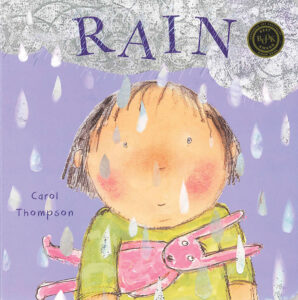Receptive language, Expressive language
Toddlers participate in a book sharing focused on wind.



[Invite several toddlers to join you to read a book. Show the cover of the book. Point to specific images on the cover when discussed.]
Our book is about a windy day.
What is happening in this picture that tells us it is a windy day?
[Follow-up prompt, if needed: “What do we see?”
Pause for toddlers to respond. Repeat and expand comments. If not mentioned by toddlers, point out the leaves blowing around, a child’s hair being blown, and a child holding onto a hat that is being blown by the wind.]
Our book is called Wind. Our book uses some fun words to tell us about wind.
 [Open the book. Hold the book close to the toddlers. Follow the words with your finger as you read. Below are strategies for engaging toddlers in the book:
[Open the book. Hold the book close to the toddlers. Follow the words with your finger as you read. Below are strategies for engaging toddlers in the book:
The words in our book told us about a windy day. The wind swooshed and soared! The pictures helped us understand the story. The wind blew the children’s hair and snatched a hat! What else did the wind blow in our story?
Toddlers will enjoy the interesting words and whimsical illustrations in this book. Many toddlers will likely repeat some of the words with you; others may prefer to watch and listen. Spend more time on pictures that seem to be of special interest to toddlers.
Extra support
Enrichment
Receptive language, Expressive language
Toddlers participate in a book sharing that includes a follow-up opportunity to draw something blowing in the wind.



Be Prepared: Tape the paper to a low table.
 Invite several toddlers to join you to read a book. Read the story, emphasizing the words that describe the wind. Invite toddlers to repeat some of the words with you. Example: “This word is ‘swoosh.’ Let’s have fun saying ‘swoosh’ together.” Use strategies suggested in Option 1 for sharing the book.
Invite several toddlers to join you to read a book. Read the story, emphasizing the words that describe the wind. Invite toddlers to repeat some of the words with you. Example: “This word is ‘swoosh.’ Let’s have fun saying ‘swoosh’ together.” Use strategies suggested in Option 1 for sharing the book.
At the conclusion of the story, invite toddlers to the low table covered with paper. Make crayons available. Encourage toddlers to pretend the white paper is the sky. We can draw things on the paper that are being blown by the wind. Offer suggestions from the book of things blown by the wind. Show book illustrations if toddlers seem confused by your specific suggestions, but do not encourage toddlers to copy what is shown in the book. Encourage toddlers to draw what they wish. Talk with toddlers about their marks on the paper. Make reference to the story, if possible. Example: “You’re drawing the dog’s ears. The wind made the dog’s ears stand up!” Print a simple title on the paper (such as A Windy Day) and display the paper on a wall for the day.
The drawing segment of the activity is likely to be brief for some toddlers and involve marks that are not recognizable images. These are developmentally appropriate expectations of a drawing activity at this age. Remember that marks are meaningful. The drawing opportunity supports (1) the cognitive tasks of reflecting on and representing a specific aspect of the story or some other experience, and (2) the fine motor task of holding and manipulating a drawing tool. Some toddlers may not be interested in drawing with the crayons and may leave the activity. Others may enjoy making marks as you talk with them about the story or their experiences with wind and their actions with the crayons. See the Option 1 What to Look For description regarding the book reading segment of the activity.
Extra support
Enrichment
Receptive language, Expressive language
Toddlers participate in a book sharing that includes a follow-up opportunity to make pretend rain in a water table activity.



Be Prepared: Put 2–3 inches of warm water in the water table or tub.
 Invite several toddlers to read a silly book about a rainy day. The strategies described below can help toddlers understand the story and expand their understanding of words:
Invite several toddlers to read a silly book about a rainy day. The strategies described below can help toddlers understand the story and expand their understanding of words:
At the conclusion of the story, invite the toddlers to make rain at the water table. Demonstrate how to squeeze a sponge to make “rain.” Remind toddlers we keep the water inside our table. Give each toddler a sponge and encourage toddlers to explore the sponges in the water. Talk with toddlers about their explorations and describe their actions. Example: “Christopher is squeezing the sponge and watching the water drip down!” Draw attention to the sounds of “rain” hitting water in the table. Example: “What do we hear?”
This enjoyable book and follow-up activity directly connect to the Block 8 Cognitive activity plan focused on watching and making water move. During the water segment of the activity, look for signs of “we know about squeezing sponges!” and help toddlers recall prior experiences with sponges in water.
The unique opportunity of the current option is to pretend the water is rain, and to represent parts of the story through the sensory experience of making raindrops.
Look for ways to help toddlers connect the water experiences to the book. Use some of the words offered in the book, such as “plip,” “plop” and “splash.” You also may wish to talk with toddlers about how the water feels, such as “wet” or “cold.” Some toddlers will enjoy working with the sponges, and others may use their hands to explore the water and maybe make raindrops by cupping their hands or letting water flow through their fingers. Positively acknowledge all ways of making raindrops.
The book’s silly descriptions of the rain can enhance toddlers’ understanding of words, and the illustrations of the child playing in the puddles are likely to be familiar to toddlers. Some toddlers may repeat some of the words with you.
Extra support
Enrichment
Materials Needed: Wind by Carol Thompson, Rain by Carol Thompson, several age-appropriate crayons (such as Crayola® My First Palm Grip Crayons for ages 12 months and up), drawing paper
Look at and talk about illustrations in the books with several toddlers. The illustrations appear similar to crayon drawings and may encourage toddlers to make their own drawings on paper. Talk with toddlers about their drawings. If a toddler provides words to describe a drawing, ask if he/she would like you to write his/her words on the paper.
Materials Needed: Rain by Carol Thompson, water table, several large foam sponges
Involve older toddlers and preschool-age children in your setting with the Option 3 sensory activity at the water table. Children gathered at the table might like to take turns making raindrop sounds by squeezing their sponges and exploring what happens with slower versus faster squeezes.